
Hi Everybody!!
I found an interesting insect to share with you. I have always called these walking sticks, but the correct name is: Phasmatodea. I see one or two a year at this location. This little guy is a record holder in the insect world due to mating behavior. The Wikipedia Info shared below reveals: "Mating behavior in Phasmatodea is impressive because of the extraordinarily long duration of pairings". One pairing reported lasting 79 days! Never a dull moment in Nature where something is always happening. I encourage you all to notice more about the world around you. Enjoy!




https://plus.google.com/u/0/photos/117645114459863049265/albums/6055560227310492017

https://en.wikipedia.org/wiki/Phasmatodea
Phasmatodea
From Wikipedia, the free encyclopedia
| Phasmatodea Temporal range: 55.8–0Ma Eocene - Recent | |
|---|---|
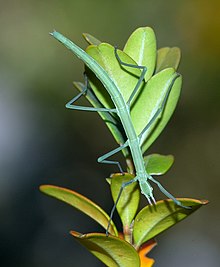 | |
| Leptynia hispanica | |
| Scientific classification | |
| Kingdom: | Animalia |
| Phylum: | Arthropoda |
| Class: | Insecta |
| Superorder: | Exopterygota |
| Order: | Phasmatodea Jacobson & Bianchi, 1902 |
Anatomy[edit]
Phasmids can be relatively large, ranging from 1.5 centimetres (0.59 in) to over 30 centimetres (12 in) in length. Females of the genus Phobaeticus are the world's longest insects, measuring up to 56.7 centimetres (22.3 in) in total length in the case of Phobaeticus chani, including the outstretched legs.[1]Females of the species Heteropteryx dilatata are the heaviest known phasmids, possibly weighing in excess of 65 grams.[2]
Some have cylindrical stick-like bodies, while others have flattened, leaflike shapes. The thorax is long in the winged species, since it houses the flight muscles, but is typically much shorter in the wingless forms. Where present, the first pair of wings is narrow and cornified, while the hind wings are broad, with straight longitudinal veins and multiple cross-veins. The body is often further modified to resemble vegetation, with ridges resembling leaf veins, bark-like tubercles, and other forms of camouflage. A few species, such as Carausius morosus, are even able to change their pigmentation to match their surroundings. Many species are wingless, or have reduced wings.[3] The mouthparts project out from the head. Chewing mandibles are uniform across species. The legs are typically long and slender, and some species are capable of limb autotomy.[3] They have long, slender antennae, as long or longer than the length of the body in some species.
All phasmids possess compound eyes, but ocelli are only found in some winged males.[3] Phasmids have an impressive visual system that allow them to perceive significant detail even in dim conditions, which suits their typically nocturnal lifestyle. They are born equipped with tiny compound eyes with a limited number of facets. As the insect grows through successive molts, the number of facets is increased along with the number ofphotoreceptor cells in the eye. The sensitivity of the adult eye is at least tenfold that of the first instar nymphs. As the eye grows more complex, the mechanisms to adapt to dark/light changes are also enhanced: eyes in dark conditions evidence less screening pigments, which would block light, than during the daytime, and changes in the width of the retinal layer to adapt to changes in available light are significantly more pronounced in adults. However, the larger size of the adult insects' eyes makes them more prone to radiation damage. This explains why fully grown individuals are mostly nocturnal. Lessened sensitivity to light in the newly emerged insects helps them to escape from the leaf litterwherein they are hatched and move upward into the illuminated foliage. Young stick insects are diurnal feeders and will move around freely, expanding their foraging range.[4]
Defense mechanisms[edit]
Further information: Camouflage and Deimatic behaviour
Phasmatodea species exhibit mechanisms for defense from predators that both prevent an attack from happening in the first place (primary defense) and are deployed after an attack has been initiated (secondary defense).
The defense mechanism most readily identifiable with Phasmatodea is camouflage, in the form of plant mimicry. Most phasmids are known for effectively replicating the forms of sticks and leaves, and the bodies of some species (such as Pseudodiacantha macklotti and Bactrododema centaurum) are covered in mossy or lichenous outgrowths that supplement their disguise. Some species have the ability to change color as their surroundings shift (Bostra scabrinota, Timema californica). In a further behavioral adaptation to supplement crypsis, a number of species perform a rocking motion where the body is swayed from side to side; this is thought to mimic the movement of leaves or twigs swaying in the breeze. Another method by which stick insects avoid predation and resemble twigs is by feigning death (thanatosis), where the insect enters a motionless state that can be maintained for a long period. The nocturnal feeding habits of adults also help Phasmatodea to remain concealed from predators.
In a seemingly opposite method of defense, many species of Phasmatodea seek to startle the encroaching predator by flashing bright colors that are normally hidden, and making a loud noise. When disturbed on a branch or foliage, some species, while dropping to the undergrowth to escape, will open their wings momentarily during free fall to display bright colors that disappear when the insect lands. Others will maintain their display for up to 20 minutes, hoping to frighten the predator and convey the appearance of a larger size. Some accompany the visual display with noise made by rubbing together parts of the wings or antennae.
Some species, such as the young nymphs of Extatosoma tiaratum, have been observed to curl the abdomen upwards over the body and head to resemble ants or scorpions in an act of mimicry, another defense mechanism by which the insects avoid becoming prey.
When threatened, some phasmids that are equipped with femoral spines on the metathoracic legs (Oncotophasma martini, Eurycantha calcarata,Eurycantha horrida, Diapheromera veliei, Diapheromera covilleae) respond by curling the abdomen upward and repeatedly swinging the legs together, grasping at the threat. If the menace is caught, the spines can draw blood and inflict considerable pain.[5]
A number of species are equipped with a pair of glands at the anterior edge of the prothorax that enables the insect to release defensive secretions, including chemical compounds of varying effect: from the production of distinct odors to the causing of a stinging, burning sensation in the eyes and mouth of a predator.[6] The spray often contains pungent-smelling volatile metabolites, previously thought to be concentrated in the insect from its plant food sources. However, based on recent research, it seems more likely that they manufacture their own chemical defense substances.[7] Additionally, the chemistry of the defense spray from at least one species, Anisomorpha buprestoides, has been shown to vary[7] based on their life stage and/or population.[8] This chemical spray variation also corresponds with regionally specific color form populations in Florida which also have distinct behaviors.[9] The spray from one species, Megacrania nigrosulfurea, is used as a treatment for skin infections by a tribe in Papua New Guinea because of its antibacterial constituents.[10] Some species employ a shorter-range defensive secretion, where individuals bleed reflexively through the joints of their legs and the seams of the exoskeleton when bothered, allowing the blood (hemolymph), which contains distasteful additives, to discourage predators. Stick insects, like their distant relative the grasshopper, can also discharge the contents of their stomachs through vomiting when harassed, a fluid considered inedible by some predators.
Life cycle[edit]
The life cycle of the stick insect begins when the female deposits her eggs through one of these methods of oviposition: she will either flick her egg to the ground by a movement of the ovipositor or her entire abdomen, carefully place the eggs in the axils of the host plant, bury them in small pits in the soil, or stick the eggs to a substrate, usually a stem or leaf of the food plant.[5] A single female lays from 100 to 1,200 eggs after mating, depending on the species.
Many species of phasmids are parthenogenic, meaning the females lay eggs without needing to mate with males to produce offspring. Stick insect species that are the product of hybridisation are usually obligate parthenogens,[11] but non-hybrids are facultative parthenogens, meaning they retain the ability to mate and are bisexual depending on the presence and abundance of males.[12] Eggs from virgin mothers are entirely female and exact copies of their mothers.
Phasmatodea eggs resemble seeds in shape and size, and have hard shells. They have a lid-like structure called an operculum at the anterior pole, from which the nymph emerges during hatching. The eggs vary in the hatching period, from 13 to more than 70 days, with the average around 20–30 days.[5]Some species, particularly those from temperate regions, undergo diapause, where development is delayed during the winter months. Diapause is affected by photoperiod on the egg-laying adults or can be genetically determined. Diapause is broken by exposure to the cold of winter, causing the eggs to hatch during the following spring. Among species of economic importance, diapause affects the development of two-year cycles of outbreaks.
Many species' eggs bear a fatty, knoblike capitulum that caps the operculum. This structure attracts ants because of its resemblance to theelaiosome of some plant seeds that are sought-after food sources for ant larvae, and usually contribute to ensuring seed dispersal by ants, a form of ant-plant mutualism called myrmecochory. The ants take the egg into their nest underground and can remove the capitulum to feed to their larvae without harming the phasmid embryo. There, the egg hatches and the young nymph, which initially resembles an ant (another instance of mimicry among Phasmatodea), eventually emerges from the nest and climbs the nearest tree to safety in the foliage.[5]
The Phasmatodea life cycle is hemimetabolous, proceeding through a series of several nymphal instars. The stick insect’s wings develop externally. As is the case with hatching, if the nymph is caught in the encasing of a rejected cast skin (or shell), it will likely die because it cannot free itself. Once emerged, the nymphs will eat the cast skin. Adulthood is reached for most species after several months and many molts. The lifespan of Phasmatodea varies by species, but ranges from a few months to up to two years for some tropical varieties.
Ecology[edit]
Phasmids are herbivorous, feeding mostly on the leaves of trees and shrubs, and a conspicuous component of many neotropical (South American) systems. Phasmatodea have been postulated as dominant light-gap herbivores there. Their role in the forest ecosystem is considered important by many scientists, who stress the significance of light gaps in maintaining succession and resilience in climax forests. By lowering the net production of early successional plants by consuming them and then augmenting the nutrients in the soil available to later successional plants through defecation, the walking stick ensures the tendency of early successional plants to swiftly immobilize soil nutrients in light gaps does not stymie new substantial growth and the recycling of the tropical forest.[13]
Phasmatodea are recognized as injurious to forest and shade trees by defoliation. Didymuria violescens, Podacanthus wilkinsoni and Ctenomorphodes tessulatus in Australia, Diapheromera femorata in North America and Graeffea crouani in coconut plantations in the South Pacific all occur in outbreaks of economic importance. Indeed, in the American South, as well as in Michiganand Wisconsin, the walking stick is a significant problem in parks and recreation sites where it consumes the foliage of oaks and other hardwoods. Severe outbreaks of the walkingstick,Diapheromera femorata, have occurred in the Ouachita Mountains of Arkansas and Oklahoma. The insects eat the entire leaf blade. In the event of heavy outbreaks, entire stands of trees can be completely ravaged. Continuous defoliation over several years often results in the death of the tree. Fortunately for control efforts, because the insects cannot fly, infestations are typically contained to a radius of a few hundred yards. Nevertheless, the damage incurred to parks in the region is often costly. Control efforts in the case of infestations have typically involved chemicalpesticides. However, investigations have been made into natural enemies of Phasmatodea, such as birds and parasitic wasps (such as the cleptid wasp Myrmecomimesis).[citation needed]
Behavior
Stick insects, like praying mantises, show rocking behavior in which the insect makes rhythmic, repetitive, side-to-side movements. The common interpretation of this behavior's function is it enhances crypsis by mimicking vegetation moving in the wind. However, these movements may be most important in allowing the insects to discriminate objects from the background by relative motion. Rocking movements by these generally sedentary insects may replace flying or running as a source of relative motion to help them discern objects in the foreground.[18]
Mating behavior in Phasmatodea is impressive because of the extraordinarily long duration of pairings. A record among insects, the stick insectNecroscia sparaxes, found in India, is sometimes coupled for 79 days at a time. It is not uncommon for this species to assume the mating posture for days or weeks on end, and among some species (Diapheromera veliei Walsh and D. Covilleae), pairing has been observed to last three to 136 hours in captivity.[19] Explanations for this behavior range from males guarding their mates against reproductive competitors to the view that the pairings are a defensive alliance.
Instances of overt displays of aggression between males over mates would suggest the extended pairing behavior may have evolved to guard females against sperm competition. Fighting between competing males has been observed in the species D. veiliei and D. covilleae.[20] During these encounters, the approach of a challenger causes the existing mate to manipulate the female's abdomen, which he has clasped by means of the clasping organ, or vomer, down upon itself to block the site of attachment. Occasionally, the consort will strike out at the competitor with the mid femora, which are equipped with an enlarged and hooked spine in both sexes that has been observed to draw the blood of the opponent when they are flexed against the body to puncture the integument.[20]
Usually, a strong hold on the female's abdomen and blows to the intruder are enough to deter the unwanted competition, but occasionally the competitor has been observed to employ a sneaky tactic to inseminate the female. While the first mate is engaged in feeding and is forced to vacate the dorsal position, the intruder can clasp the female's abdomen and insert his genitalia. If he is discovered, the males will enter into combat wherein they lean backward, both clasped to the female's abdomen, and freely suspended, engage in rapid, sweeping blows with their forelegs in a manner similar to boxing. Usually, when the intruder gains attachment to the female's abdomen, these conflicts resolve in the displacement of the original mate.[20]
Lengthy pairings have also been described in terms of a defensive alliance.[19] When cleaved together, the pair is more unwieldy for predators to handle. Also, the chemical defenses (secretions, reflex bleeding, regurgitation) of the individual stick insect are enhanced when two are paired. Female survivorship of attacks by predators is significantly enhanced by pairing, largely because the dorsal position of the male functions well as a shield. This could indicate manipulation by females is present: if females accept ejaculate at a slow rate, for instance, the males are forced to remain in copulo for longer and the female's chances of survival are enhanced. Also, evolution could have simply favored males that remained attached to their females longer, since females are often less abundant than males and represent a valuable prize, so for the lucky male, even the sacrifice of his own life to preserve his offspring with the female may be worth it.
Sexual dimorphism in the species, where females are usually significantly larger than the males, may have evolved due to the fitness advantage accrued to males that can remain attached to the female, thereby blocking competitors, without severely impeding her movement.
(See above link for complete Article)

...this is brendasue signing off from Rainbow Creek. See you next time.

O+O

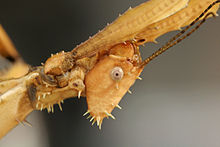


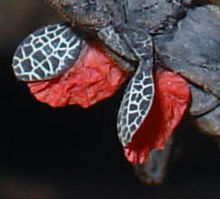
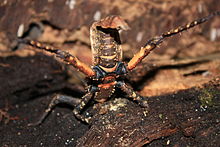

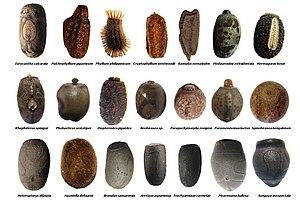
No comments:
Post a Comment